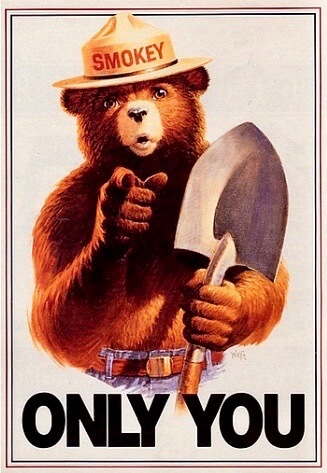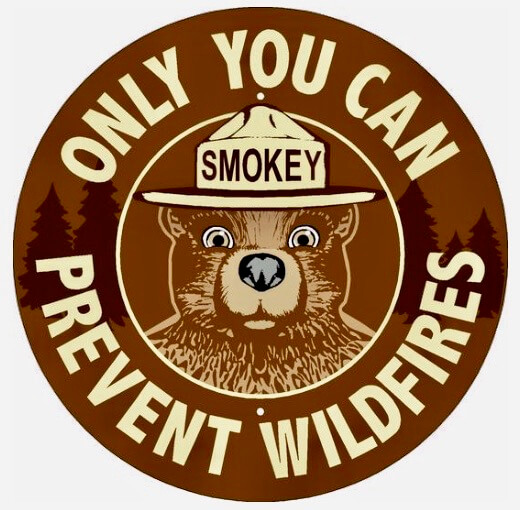
I loved Smokey the Bear growing up — probably because his story of renewal was inspiring to me. Out of the charcoal of a tinderbox forest fire in New Mexico, he was rescued, made a “spokes-bear”, and inspired generations to come. I remember Smokey saying, “Only YOU can prevent forest fires.” So I wonder, as my beloved Pacific Northwest burns in so many different fires and the smothering smoke and ash besieges populated areas up and down the West Coast, how can we prevent forest fires? An earnest, renewed focus on reversing human impact on the environment would be an obvious first course for society at large.
I’m often inspired to express the sense of renewal I feel from exploring the forests and waterways that make the Pacific Northwest a wonderland of nature. It pains me to hear about all the destruction of favorite recreation areas, let alone the communities and people impacted — evacuating their homes in a “go now” frenzy. Travel and meaningful connections also include the pain of tragedy and loss associated with knowing some of these places will never be the same again, for generations.
But in a spiritual, metaphorical way, how do we sit up and listen to the messages coming from nature? Once the unrelenting heat of the fires start burning through all we love, even to the point of choking our lungs and watering our eyes, how can we extinguish it? What this means is different to each of us, yet we all play a role in the next chapter of our country.
What’s it like to not be able to breathe? I didn’t really know until this week, as the smoke from surrounding fires burned away the Pacific Northwest forests, laying a thick veil over Seattle and other cities along the West Coast. This falls in line with other ‘fires’ of devastation in 2020 — COVID placing the knee on the neck of our economy and everyday life as we knew it, continuing with mostly peaceful protests inspired by a tipping point brought about by the murder of George Floyd. His literal suffocation could be a metaphor for the many ways we are choked daily, both physically and emotionally.
How does fire become stronger? After the spark, it exploits oxygen, fuel and heat to expand control over a surrounding environment, spreading the molten cinders in any direction. Take away any of these elements — like oxygen — and the fire loses power, until eventually the smoldering ash is all that remains. This is how I see our country right now — some media love the images of cars burning as the moniker of civil unrest in Portland and Seattle, yet the cities are not actually burning. The forests around the metro zones are up in flames (leading to suffocating air), and there certainly is rage burning against inequality, but Portland and Seattle are intact.
The Rose and Emerald cities are very much alive the same way the moles, northern pocket gophers and ants were living underground when Mt. St. Helens erupted on May 18, 1980. When the dust started to settle — and there was a lot of ash — these survivors were the first to pop up and get to work mixing the previous nutrient rich topsoil, now a few feet below the ash, with the talcum-like silt layered upon everything. This started the immediate chain reaction that rebuilt the glorious mountain to a natural marvel today — different from before but still astonishing. Notably, this path of nature surprised conventional science and remains an intriguing study to this day.
Speaking of popping up from the ashes, last weekend I took an evening stroll through the former CHOP area of my Capitol Hill neighborhood, noting the quiet streets — quiet in a good way. Peaceful. It did seem post-apocalyptic, knowing that this traditional nightlife zone of the city would normally be ablaze with willing participants from all corners of King County — coming together to eat, drink, dance and carouse into the wee hours. But the feeling emitted an optimistic vibe that, just like branches of a tree that go dormant in the winter, life is still pulsing.
The boarded up buildings in Seattle were mostly a precaution in the beginning days of COVID and conveniently served as canvasses for art during the CHOP and general Black Lives Matter protests — despite the “cities in shambles” narrative. Stout Restaurant, which closed in February prior to COVID, sits in the middle of what once was the CHOP. Today on my walk through the area I noticed a work crew removing the colorful plywood and the clarity of the glass felt liberating to me. What comes next, time will tell, but the lifting of the veil is happening in small doses.
Even as I can taste the gritty remnants of fire in my mouth bringing this email to life, ultimately I know the fires will give way to earth, preventing further movement, and the wind might even stop cooperating. Then water will fall from the sky and a balance will once again fall upon the Pacific Northwest. At that time we’ll emerge from the fires like the moles, northern pocket gophers, and ants — just in time to exhibit our individual power to add to the collective energy to push our country forward and rebuild. So please, register to vote and if you’re already set up, come up with your plan to make your voice heard and counted.
Stay safe and sane!
Matthew
PS — This email today referenced two articles I wrote earlier this summer about the Capitol Hill Occupied Protest (CHOP) and the May 18, 1980 eruption of Mount St. Helens. The information for each is below.

